Nellie Bly
| Elizabeth Jane Cochran | |
|---|---|
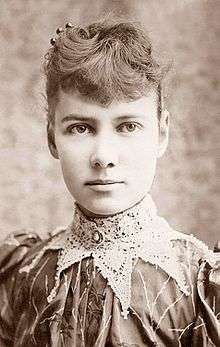 Elizabeth Cochran, "Nellie Bly" | |
| Born |
Elizabeth Jane Cochran May 5, 1864 Cochran's Mills, Pennsylvania, United States |
| Died |
January 27, 1922 (aged 57) New York City, New York, United States |
| Nationality | American |
| Occupation | Journalist, novelist, inventor |
| Spouse(s) | Robert Seaman (m. 1895–1904) |
| Awards | National Women's Hall of Fame (1998) |
| Signature | |
 | |
| Notes | |
|
After her marriage, Bly used the name "Elizabeth Cochrane Seaman" as seen in the signatures on patents she filed. | |
Elizabeth Cochran Seaman[1] (May 5, 1864[2] – January 27, 1922), known by her pen name Nellie Bly, was an American journalist. She was also a writer, industrialist, inventor, and a charity worker who was widely known for her record-breaking trip around the world in 72 days, in emulation of Jules Verne's fictional character Phileas Fogg, and an exposé in which she faked insanity to study a mental institution from within.[3] She was a pioneer in her field, and launched a new kind of investigative journalism.[4]
Early life, education and early career

At birth she was named Elizabeth Jane Cochran. She was born in "Cochran's Mills",[5] today part of the Pittsburgh suburb of Burrell Township, Armstrong County, Pennsylvania.[6][7][8] Her father, Michael Cochran, was a laborer and mill worker who married Mary Jane. His father had immigrated from County Londonderry, Ireland in the 1790s. Cochran taught his young children a cogent lesson about the virtues of hard work and determination, buying the local mill and most of the land surrounding his family farmhouse. As a young girl Elizabeth often was called "Pinky" because she so frequently wore the color. As she became a teenager she wanted to portray herself as more sophisticated, and so dropped the nickname and changed her surname to "Cochrane".[9] She attended boarding school for one term, but was forced to drop out due to lack of funds.
In 1880 Cochrane and her family moved to Pittsburgh. An aggressively misogynistic column entitled "What Girls Are Good For" in the Pittsburgh Dispatch prompted her to write a fiery rebuttal to the editor under the pseudonym "Lonely Orphan Girl".[10][11][12] The editor, George Madden, was impressed with her passion and ran an advertisement asking the author to identify herself. When Cochrane introduced herself to the editor, he offered her the opportunity to write a piece for the newspaper, again under the pseudonym "Lonely Orphan Girl".[12] After her first article for the Dispatch, entitled "The Girl Puzzle", Madden was impressed again and offered her a full-time job.[11] Women who were newspaper writers at that time customarily used pen names. The editor chose "Nellie Bly", adopted from the title character in the popular song "Nelly Bly" by Stephen Foster.[13] Cochrane originally intended that her pseudonym be "Nelly Bly", but her editor wrote "Nellie" by mistake and the error stuck.
As a writer, Bly focused her early work for the Dispatch on the plight of working women, writing a series of investigative articles on women who were factory workers, but editorial pressure pushed her to the so-called "women's pages" to cover fashion, society, and gardening, the usual role for women journalists of the day. Dissatisfied with these duties, she took the initiative and traveled to Mexico to serve as a foreign correspondent. Still only 21, she spent nearly half a year reporting the lives and customs of the Mexican people; her dispatches later were published in book form as Six Months in Mexico. In one report, she protested the imprisonment of a local journalist for criticizing the Mexican government, then a dictatorship under Porfirio Díaz. When Mexican authorities learned of Bly's report, they threatened her with arrest, prompting her to leave the country. Safely home, she denounced Díaz as a tyrannical czar suppressing the Mexican people and controlling the press.
Asylum Exposé
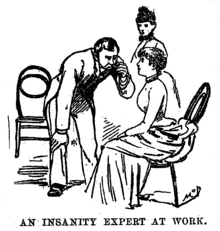
Burdened again with theater and arts reporting, Bly left the Pittsburgh Dispatch in 1887 for New York City. Penniless after four months, she talked her way into the offices of Joseph Pulitzer's newspaper, the New York World, and took an undercover assignment for which she agreed to feign insanity to investigate reports of brutality and neglect at the Women's Lunatic Asylum on Blackwell's Island.
After a night of practicing deranged expressions in front of a mirror, she checked into a boardinghouse. She refused to go to bed, telling the boarders that she was afraid of them and that they looked "crazy." They soon decided that she was "crazy," and the next morning summoned the police. Taken to a courtroom, she pretended to have amnesia. The judge concluded she had been drugged.
Several doctors then examined her; all declared her insane. "Positively demented," said one, "I consider it a hopeless case. She needs to be put where someone will take care of her."[14] The head of the insane pavilion at Bellevue Hospital pronounced her "undoubtedly insane". The case of the "pretty crazy girl" attracted media attention: "Who Is This Insane Girl?" asked the New York Sun. The New York Times wrote of the "mysterious waif" with the "wild, haunted look in her eyes" and her desperate cry: "I can't remember I can't remember."[15][16]
Committed to the asylum, Bly experienced its conditions firsthand. The food consisted of gruel broth, spoiled beef, bread that was little more than dried dough, and dirty undrinkable water. The dangerous patients were tied together with ropes. The patients were made to sit for much of each day on hard benches with scant protection from the cold. Waste was all around the eating places. Rats crawled all around the hospital. The bathwater was frigid and buckets of it were poured over their heads. The nurses behaved obnoxiously and abusively, telling the patients to shut up, and beating them if they did not. Speaking with her fellow patients, Bly was convinced that some were as sane as she was. On the effect of her experiences, she wrote:
What, excepting torture, would produce insanity quicker than this treatment? Here is a class of women sent to be cured. I would like the expert physicians who are condemning me for my action, which has proven their ability, to take a perfectly sane and healthy woman, shut her up and make her sit from 6 a.m. until 8 p.m. on straight-back benches, do not allow her to talk or move during these hours, give her no reading and let her know nothing of the world or its doings, give her bad food and harsh treatment, and see how long it will take to make her insane. Two months would make her a mental and physical wreck.[14]
"My teeth chattered and my limbs were goose-fleshed and blue with cold. Suddenly I got, one after the other, three buckets of water over my head—ice- cold water, too—into my eyes, my ears, my nose and my mouth."
After ten days the asylum released Bly at The World's behest. Her report, later published in book form as Ten Days in a Mad-House, caused a sensation and brought her lasting fame. While embarrassed physicians and staff fumbled to explain how she had deceived so many professionals, a grand jury launched its own investigation into conditions at the asylum, inviting Bly to assist. The jury's report recommended the changes she had proposed. Its call for increased funds for care of the insane prompted an $850,000 increase in the budget of the Department of Public Charities and Corrections. The grand jury also made sure that future examinations were more thorough so that only the seriously ill went to the asylum.
Around the world

In 1888 Bly suggested to her editor at the New York World that she take a trip around the world, attempting to turn the fictional Around the World in Eighty Days into fact for the first time. A year later, at 9:40 a.m. on November 14, 1889, and with two days' notice,[17] she boarded the Augusta Victoria, a steamer of the Hamburg America Line,[18] and began her 24,899-mile journey.
She took with her the dress she was wearing, a sturdy overcoat, several changes of underwear, and a small travel bag carrying her toiletry essentials. She carried most of her money (£200 in English bank notes and gold, as well as some American currency) in a bag tied around her neck.[19][20]
The New York newspaper Cosmopolitan sponsored its own reporter, Elizabeth Bisland, to beat the time of both Phileas Fogg and Bly. Bisland would travel the opposite way around the world.[21][22] To sustain interest in the story, the World organized a "Nellie Bly Guessing Match" in which readers were asked to estimate Bly's arrival time to the second, with the Grand Prize consisting at first of a free trip to Europe and, later on, spending money for the trip.[20][23]
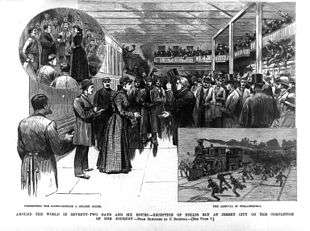
During her travels around the world, Bly went through England, France (where she met Jules Verne in Amiens), Brindisi, the Suez Canal, Colombo (Ceylon), the Straits Settlements of Penang and Singapore, Hong Kong, and Japan. The development of efficient submarine cable networks and the electric telegraph allowed Bly to send short progress reports,[24] although longer dispatches had to travel by regular post and thus were often delayed by several weeks.[23]
Bly travelled using steamships and the existing railroad systems,[25] which caused occasional setbacks, particularly on the Asian leg of her race.[26] During these stops, she visited a leper colony in China[27][28] and, in Singapore, she bought a monkey.[27][29]
As a result of rough weather on her Pacific crossing, she arrived in San Francisco on the White Star Line ship RMS Oceanic on January 21, two days behind schedule.[26][30] However, after World owner Pulitzer chartered a private train to bring her home, she arrived back in New Jersey on January 25, 1890, at 3:51 pm.[24]
Just over seventy-two days after her departure from Hoboken, Bly was back in New York. She had circumnavigated the globe, traveling alone for almost the entire journey.[18] Bisland was, at the time, still crossing the Atlantic, only to arrive in New York four and a half days later. She also had missed a connection and had had to board a slow, old ship (the Bothnia) in the place of a fast ship (Etruria).[17] Bly's journey was a world record, although it was bettered a few months later by George Francis Train, whose first circumnavigation in 1870 possibly had been the inspiration for Verne's novel. Train completed the journey in 67 days, and on his third trip in 1892 in 60 days.[31][32] By 1913, Andre Jaeger-Schmidt, Henry Frederick, and John Henry Mears had improved on the record, the latter completing the journey in fewer than 36 days.[33]
Later years
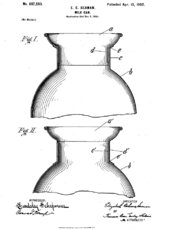
In 1895 Bly married millionaire manufacturer Robert Seaman. Bly was 31 and Seaman was 73 when they married.[34] She retired from journalism and became the president of the Iron Clad Manufacturing Co., which made steel containers such as milk cans and boilers. In 1904, her husband died. In the same year, Iron Clad began manufacturing the steel barrel that was the model for the 55-gallon oil drum still in widespread use in the United States. Although there have been claims that Bly invented the barrel,[35] the inventor is believed to have been Henry Wehrhahn, who likely assigned his invention to her. (U.S. Patents 808,327 and 808,413).[36] Bly was, however, an inventor in her own right, receiving U.S. patent 697,553 for a novel milk can and U.S. patent 703,711 for a stacking garbage can, both under her married name of Elizabeth Cochrane Seaman.[37] For a time she was one of the leading women industrialists in the United States, but embezzlement by employees resulted in the Iron Clad Manufacturing Co. going bankrupt.[38] Back in reporting, she wrote stories on Europe's Eastern Front during World War I[39] and notably covered the Woman Suffrage Parade of 1913. Her headline for the Parade story was "Suffragists Are Men's Superiors", but she also "with uncanny prescience" predicted in the story that it would be 1920 before women in the United States would win the vote.[40]
Death
Bly died of pneumonia at St. Mark's Hospital in New York City in 1922 at age 57.[5] She was interred in a modest grave at Woodlawn Cemetery in The Bronx, New York City.[41] Seven years later, Elizabeth Bisland also died of pneumonia, and she was buried in the same cemetery.[42]
Gallery
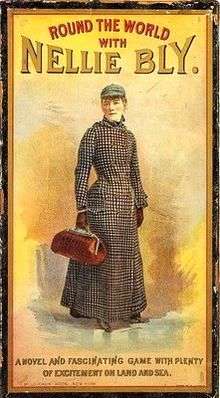 Cover of the 1890 board game Round the World with Nellie Bly
Cover of the 1890 board game Round the World with Nellie Bly Portrait of a 21-year-old Bly in Mexico
Portrait of a 21-year-old Bly in Mexico Nellie Bly in her later years
Nellie Bly in her later years- Bly's grave in Woodlawn Cemetery
Legacy
Dramatic representations
- Bly was the subject of the 1946 Broadway musical Nellie Bly, by Johnny Burke and Jimmy Van Heusen. The show ran for 16 performances.[43]
- In 1981 Linda Purl appeared as Bly in a made-for-television movie entitled The Adventures of Nellie Bly.[44]
- Julia Duffy appeared as Bly in the July 10, 1983 Voyagers! episode "Jack's Back".
- Bly is a playable character featured in the 1991 PC role-playing game Ultima: Worlds of Adventure 2: Martian Dreams.
- In 1998, Lynn Schrichte wrote and toured a one-woman show about Nellie Bly entitled Did You Lie, Nellie Bly? A video about the show can be found in a Library of Congress bio for Lynn Schrichte.
- A fictionalized account of Bly's around the world trip was used in the 2010 comic book Julie Walker is The Phantom published by Moonstone Books (Story: Elizabeth Massie, art: Paul Daly, colors: Stephen Downer).[45]
- Bly was represented in Steven Quantick's 2013 stage play version of Around the World in 80 Days, as a journalist covering the story of Fogg's exploits, who follows him around the world.
- A fictionalized account of Bly's experience while committed is used as the basis for the 2013 horror novel Bedlam Stories by Pearry Reginald Teo and Christine Converse.[46]
- is the protagonist of the 2014 historical murder mystery novel The New Colossus by Marshall Goldberg, published by Diversion Books.[47]
- A feature film by Pendragon Pictures titled 10 Days in a Madhouse after Bly's exposé was released on November 11, 2015. The film starring Caroline Barry, Christopher Lambert, Kelly Le Brock and Julia Chantrey depicts Bly's experiences on Blackwells Island.[48][49][50]
- Nellie is the protagonist of the 2015 novel by Dan Jorgensen titled "And The Wind Whispered," published by Bygone Era Books.
Eponyms and namesakes
- The Nellie Bly Amusement Park in Brooklyn, New York City, was named after her, taking as its theme Around the World in Eighty Days. The park reopened in 2007[51] under new management, renamed "Adventurers Amusement Park".[52]
- From early in the twentieth century until 1961, the Pennsylvania Railroad operated a parlor-car only express train between New York and Atlantic City that bore the name, Nellie Bly. The train was famously involved in a spectacular wreck in 1901, killing 17 people.[53]
- The New York Press Club confers an annual "Nellie Bly Cub Reporter" journalism award to acknowledge the best journalistic effort by an individual with three years or less professional experience.
- The board game Round the World with Nellie Bly created in 1890 is named in recognition of her trip.
- Nellie Bly Kaleidoscope Shop[54] in Jerome, AZ is the world's largest kaleidoscope shop.
- "Nelly Bly's Olde Tyme Ice Cream Parlour" is an ice cream shop and restaurant located in Riverton, NJ.[55]
Other recognition
- In 1998 Bly was inducted into the National Women's Hall of Fame.[56]
- Bly was one of four journalists honored with a U.S postage stamp in a "Women in Journalism" set in 2002.[57]
- Bly's investigation of the Blackwell's Island insane asylum is dramatized in a 4-D film in the Annenberg Theater at the Newseum in Washington, D.C.
- Bly served as inspiration for the character Katherine Plumber from the musical adaptation of Disney's Newsies.
- A fictionalized version of Bly as a mouse, named Nellie Brie, is a central character in An American Tail: The Mystery of the Night Monster.
- The character of Lana Winters (Sarah Paulson) in American Horror Story: Asylum is inspired by Bly's experience in the asylum.
- The character of Maggie Dubois in The Great Race (1965) played by Natalie Wood is loosely inspired by Bly.
- A fictionalized story of Bly teaming up with Jules Verne, Oscar Wilde, and Louis Pasteur to catch a killer at the 1889 Paris Worlds Fair appears in The Alchemy of Murder by Carol McCleary.
- On May 5, 2015, the Google search engine produced an interactive "Google Doodle" for Bly; for the "Google Doodle" Karen O wrote, composed, and recorded an original song about Bly and Katy Wu created an animation set to Karen O's music.[58]
- On June 1, 2015, a fictionalized story of Nellie – "And The Wind Whispered" – has her teaming up with lawmen Bat Masterson and Seth Bullock to solve a murder in the Southern Black Hills.
See also
- Bicho de Sete Cabeças, 2001 Brazilian film about life in a mental hospital
- List of female adventurers
- Nellie Bly Cub Reporter Award
- Rosenhan experiment, 1970s, being sane in an insane place
- Winifred Bonfils, another pioneering woman journalist
References
- ↑ Bill DeMain. "Ten Days in a Madhouse: The Woman Who Got Herself Committed". mental floss. Retrieved 2010-05-10.
- ↑ Kroeger 1994 reports (p. 529) that although a birth year of 1867 was deduced from the age Bly claimed to be at the height of her popularity, her baptismal record confirms 1864.
- ↑ "Five Reasons why a Google Doodle Tribute to Nellie Bly is justified". news.biharprabha.com. May 5, 2015. Retrieved May 5, 2015.
- ↑ "American Experience". pbs.org.
- 1 2 "Nellie Bly, journalist, Dies of Pneumonia". The New York Times. The New York Times Co. January 28, 1922. Retrieved November 29, 2011.
- ↑ "Nellie Bly" (PDF). Pittsburghclo.org. Retrieved 2013-07-20.
- ↑ "Nellie Bly Historical Marker". Explorehistory.com. Retrieved 2013-07-20.
- ↑ "Cochran's Mill Rd over Licks Run – Bridges and Tunnels of Allegheny County and Pittsburgh, PA". Pghbridges.com. Retrieved 2013-07-20.
- ↑ Kroeger 1994, p. 25.
- ↑ "Young and Brave: Girls Changing History". National Woman's History Museum. Retrieved April 7, 2014.
- 1 2 Arthur Fritz. "Nellie Bly, (1864–1922)". Nellie Bly Online. Retrieved April 7, 2014.
- 1 2 Jone Johnson Lewis. "Nellie Bly". About.com. Retrieved April 7, 2014.
- ↑ Adrian Room (July 1, 2010). Dictionary of Pseudonyms: 13,000 Assumed Names and Their Origins, 5th ed. McFarland. p. 182. ISBN 978-0-7864-5763-2.
- 1 2 Bly 1887.
- ↑ Kroeger 1994, pp. 91–92.
- ↑ http://query.nytimes.com/mem/archive-free/pdf?res=9500EEDC1530E633A25755C2A96F9C94669FD7CF
- 1 2 Ruddick, Nicholas. "Nellie Bly, Jules Verne, and the World on the Threshold of the American Age." Canadian Review of American Studies, Volume 29, Number 1, 1999, p. 4
- 1 2 Kroeger, Brooke. Nellie Bly – Daredevil, reporter, Feminist. Times Books Random House, 1994, p. 146
- ↑ Kroeger, Brooke. Nellie Bly – Daredevil, reporter, Feminist. Times Books Random House, 1994, p. 141
- 1 2 Ruddick, Nicholas. "Nellie Bly, Jules Verne, and the World on the Threshold of the American Age." Canadian Review of American Studies, Volume 29, Number 1, 1999, p. 5
- ↑ Barcousky, Len. "Eyewitness 1890: Pittsburgh welcomes home globe-trotting Nellie Bly", Pittsburgh Post-Gazette, August 23, 2009, accessed January 30, 2011
- ↑ "Society Topics of the Week.", The New York Times, November 24, 1889, accessed January 30, 2011
- 1 2 Kroeger, Brooke. Nellie Bly – Daredevil, reporter, Feminist. Times Books Random House, 1994, p. 150
- 1 2 Ruddick, Nicholas. "Nellie Bly, Jules Verne, and the World on the Threshold of the American Age." Canadian Review of American Studies, Volume 29, Number 1, 1999, p. 8
- ↑ Ruddick, Nicholas. "Nellie Bly, Jules Verne, and the World on the Threshold of the American Age." Canadian Review of American Studies, Volume 29, Number 1, 1999, p. 6
- 1 2 Bear, David. "Around the World With Nellie Bly." Pittsburgh Post-Gazette, November 26, 2006
- 1 2 Ruddick, Nicholas. "Nellie Bly, Jules Verne, and the World on the Threshold of the American Age." Canadian Review of American Studies, Volume 29, Number 1, 1999, p. 7
- ↑ Kroeger, Brooke. Nellie Bly – Daredevil, reporter, Feminist. Times Books Random House, 1994, p. 160
- ↑ Kroeger, Brooke. Nellie Bly – Daredevil, reporter, Feminist. Times Books Random House, 1994, p. 158
- ↑ "Daily Alta California 22 January 1890 – California Digital Newspaper Collection". Cdnc.ucr.edu. Retrieved 2013-07-20.
- ↑ George Francis Train, The Bostonian Who Really Was Phileas Fogg at the New England Historical Society
- ↑ "William Lightfoot Visscher, Journal profile, part one". Skagitriverjournal.com. Retrieved 2013-07-20.
- ↑ The New York Times, "A Run Around the World", August 8, 1913
- ↑ "Nellie Bly, journalist, Dies of Pneumonia". The New York Times.
- ↑ "The Remarkable Nellie Bly". AOGHS. December 26, 1905. Retrieved 2013-07-20.
- ↑ "Industries – Business History of Oil Drillers, Refiners". Businesshistory.com. Retrieved 2013-07-20.
- ↑ "Google". Google. Retrieved 2013-07-20.
- ↑ Garrison, Jayne (March 28, 1994). "Nellie Bly, Girl Reporter : Daredevil journalist". articles.latimes.com. Los Angeles Times. Retrieved May 5, 2015.
But her ignorance of accounting and blind affection for her cheating factory manager brought her down. The business went bankrupt, and Bly resorted to hiding her books from the courts, withholding information and warring with her family.
- ↑ The remarkable Nellie Bly, inventor of the metal oil drum, Petroleum Age, 12/2006, p.5.
- ↑ Harvey, Sheridan (2001). "Marching for the Vote: Remembering the Woman Suffrage Parade of 1913". American Women. Library of Congress. Retrieved March 3, 2013.
- ↑ Dunning, Jennifer (February 23, 1979). "Woodlawn, Bronx's Other Hall of Fame". The New York Times. The New York Times Co. Retrieved November 29, 2011.
- ↑ "Elizabeth Bisland". Nellie Bly in the Sky. Retrieved November 29, 2015.
- ↑ "After the poorly received Nellie Bly (1946) ... [stage director Edgar J.] MacGregor retired.", musicals101.com
- ↑ The Adventures of Nellie Bly, IMDb page.
- ↑ "024. Julie Walker: The Phantom (A)". Moonstonebooks.com. Retrieved 2013-07-20.
- ↑ "Bedlam Stories". Retrieved 2013-09-24.
- ↑ "The New Colossus". diversionbooks.com/ebooks/new-colossus. Retrieved 2014-04-29.
- ↑ 10 Days in a Mad House, IMDb page.
- ↑ 10 Days in a Mad House, Website.
- ↑ STUDIES: Women still struggle in male-dominated film industry, Tom Henderson, Filmfiles.tv.
- ↑ "Adventurer's Amusement Park" UltimaterollerCoaster.com
- ↑ "Adventurer's Park Family Entertainment Center – 1824 Shore Parkway, Brooklyn, NY 11214 – (718) 975–2748". adventurerspark.com.
- ↑ "Terrible Wreck On Pennsylvania Road" The Gloversville Daily Leader February 22, 1901
- ↑ "Home". Nellie Bly Kaleidoscopes and Art Glass.
- ↑ "Catch the Scoop on Riverton's Old-Fashioned Ice Cream Shop". Moorestown, New Jersey Patch.
- ↑ "Elizabeth Jane Cochran – National Women's Hall of Fame". Greatwomen.org. Retrieved 2013-07-20.
- ↑ USPS Press Release (September 14, 2002), Four Accomplished Journalists Honored on U.S. Postage Stamps, usps.com
- ↑ "What Girls are Good For: Happy birthday Nellie Bly". May 4, 2015. Retrieved 2015-05-05.
Bibliography
- Affidavit of Beatrice K. Brown; Surrogates Court, Kings County (1922)
- Goodman, Matthew (2013). Eighty Days: Nellie Bly and Elizabeth Bisland's History-Making Race Around the World.
- Kroeger, Brooke (1994). Nellie Bly: Daredevil, Reporter, Feminist.
External links
| Wikimedia Commons has media related to Nellie Bly. |
| Library resources about Nellie Bly |
| By Nellie Bly |
|---|
 Works written by or about Nellie Bly at Wikisource
Works written by or about Nellie Bly at Wikisource- Information, photos and original Nellie Bly articles at Nellie Bly Online
- Nellie Bly's collected journalism at The Archive of American Journalism
- Editions of Bly's books at the Celebration of Women Writers:
- An account of Bly's trip around the world
- American Experience | Around The World In 72 Days, a documentary about Bly's trip around the world
- Daily Alta California, January 22, 1890
- The Daring Nellie Bly: America's Star Reporter illustrated biography by Bonnie Christensen, reviewed by Maria Popova
- Works by Nellie Bly at Project Gutenberg
- Works by or about Nellie Bly at Internet Archive
- Works by Nellie Bly at LibriVox (public domain audiobooks)
